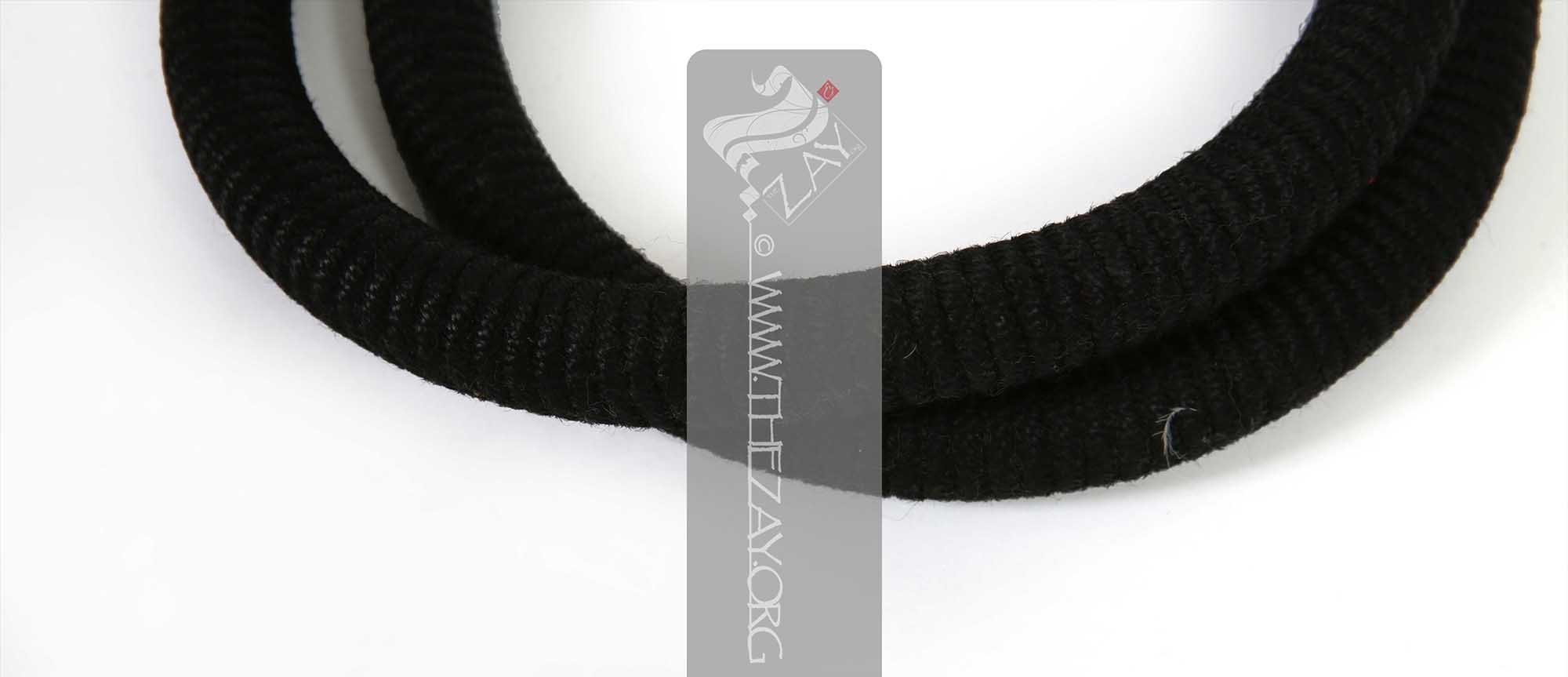






| Local Name | ‘Igal |
| Object Category | Accessory |
| Gender | Male |
| Date of object | c. 20th century |
| Place Of orgin | Syria |
| Region | - |
| Object Range | Syria, Jordan, Palestine, Lebanon, Iraq, Kuwait, Oman, Qatar, Bahrain, UAE, Saudi Arabia, Yemen, Egypt et al |
| Dimensions | Length: 20 cm Width: 20 cm |
| Materials | Wool Animal Hair |
| Technique | Other |
| Color | |
| Provenance | Donated, Raeda Daboul, UAE 2021 |
| Location | The Zay Zay: (Arabic: costume, Pl. azyaā’), a set of clothes in a style typical of a particular country or historical period. Initiative |
| Status | In Storage |
| ZI number | ZI2021.500964e SYRIA |
Object Note
Part of a lot with five other items (ZI2021.500964 SYRIA, ZI2021.500964a SYRIA, ZI2021.500964b SYRIA, ZI2021.500964c SYRIA, and ZI2021.500964d SYRIA) also in the collection.
Object History
This piece was donated to The Zay Zay: (Arabic: costume, Pl. azyaā’), a set of clothes in a style typical of a particular country or historical period. Initiative by Ms Raeda Daboul in UAE 2021, to enhance the collection.
Ms Daboul commenced her journey with Gulf Media as a student at Damascus University. With a bachelor's degree in journalism and media, she relocated to the UAE and specialized in Emirati and Gulf cultural, historical, and social aspects. Her passion for the Arabic language propelled her into the world of books, engaging in both authoring and editing. Additionally, Ms Daboul served as a media coordinator for numerous media programs and activities. Currently settled in Vancouver, Canada she is also a regular contributor to The Zay Zay: (Arabic: costume, Pl. azyaā’), a set of clothes in a style typical of a particular country or historical period. Initiative’s cause.
Object Features
This is a men’s headband (‘Igal)possibly composed of animal hair base, most likely camel’s and tightly wrapped in a braided woollen ribbon of different thicknesses.
More Info
The shatfah
Shatfah: (Arabic; Synonym: aqal, oqal, igal and other regional dialect and spelling variations, mgassab, faisaly), a looped headband often traditionally constructed of animal hair, later silk in corded fashion and gilded silver straw worn by Arab men of affluence as status symbol to keep their head scarves in place.
Several surviving artifacts from the Levantine antiquity provide tangible evidence of headband-wearing practices in this region since ancient times. Moreover, similar headgear was also prevalent in adjacent Greco-Roman cultures.
While the latter served as a ceremonial ornament, the shatfah
Shatfah: (Arabic; Synonym: aqal, oqal, igal and other regional dialect and spelling variations, mgassab, faisaly), a looped headband often traditionally constructed of animal hair, later silk in corded fashion and gilded silver straw worn by Arab men of affluence as status symbol to keep their head scarves in place.
Traditionally, shatfah
Shatfah: (Arabic; Synonym: aqal, oqal, igal and other regional dialect and spelling variations, mgassab, faisaly), a looped headband often traditionally constructed of animal hair, later silk in corded fashion and gilded silver straw worn by Arab men of affluence as status symbol to keep their head scarves in place. Shatfah: (Arabic; Synonym: aqal, oqal, igal and other regional dialect and spelling variations, mgassab, faisaly), a looped headband often traditionally constructed of animal hair, later silk in corded fashion and gilded silver straw worn by Arab men of affluence as status symbol to keep their head scarves in place.
The concept of the modern-day shatfah
Shatfah: (Arabic; Synonym: aqal, oqal, igal and other regional dialect and spelling variations, mgassab, faisaly), a looped headband often traditionally constructed of animal hair, later silk in corded fashion and gilded silver straw worn by Arab men of affluence as status symbol to keep their head scarves in place.
The term (faisaly
Faīṣaly: (Arabic - headband; Synonym: iqal, oqal
Oqal: (Arabic - headband; Synonym: igal, iqal, mgassab, mqassab
Mqaṣṣab: (Arabic - headband; Synonym: iqal, oqal, igal, mgassab, shatfah
Shatfah: (Arabic; Synonym: aqal, oqal, igal and other regional dialect and spelling variations, mgassab, faisaly), a looped headband often traditionally constructed of animal hair, later silk in corded fashion and gilded silver straw worn by Arab men of affluence as status symbol to keep their head scarves in place. Shatfah: (Arabic; Synonym: aqal, oqal, igal and other regional dialect and spelling variations, mgassab, faisaly), a looped headband often traditionally constructed of animal hair, later silk in corded fashion and gilded silver straw worn by Arab men of affluence as status symbol to keep their head scarves in place. Mqaṣṣab: (Arabic - headband; Synonym: iqal, oqal, igal, mgassab, shatfah
Shatfah: (Arabic; Synonym: aqal, oqal, igal and other regional dialect and spelling variations, mgassab, faisaly), a looped headband often traditionally constructed of animal hair, later silk in corded fashion and gilded silver straw worn by Arab men of affluence as status symbol to keep their head scarves in place. Shatfah: (Arabic; Synonym: aqal, oqal, igal and other regional dialect and spelling variations, mgassab, faisaly), a looped headband often traditionally constructed of animal hair, later silk in corded fashion and gilded silver straw worn by Arab men of affluence as status symbol to keep their head scarves in place. Shatfah: (Arabic; Synonym: aqal, oqal, igal and other regional dialect and spelling variations, mgassab, faisaly), a looped headband often traditionally constructed of animal hair, later silk in corded fashion and gilded silver straw worn by Arab men of affluence as status symbol to keep their head scarves in place.
Links